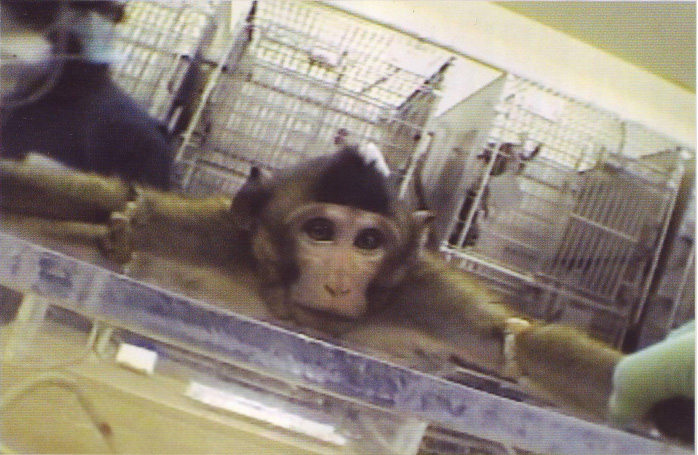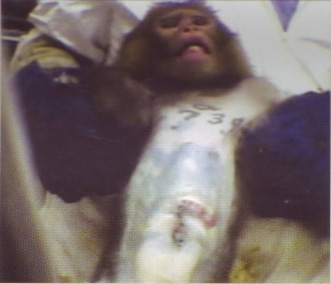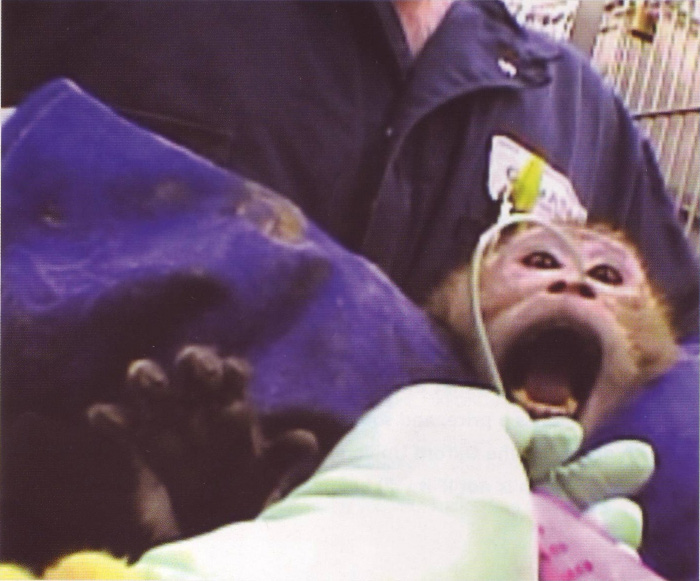Into the mouth of Hell
- the real face of vivisection
part b
 monkey from the highest dose group, was ataxic (i.e., had no motor coordination); lower dose groups developed ataxia within the next few days. Necrotic tissue developed around injection sites, so doses were injected into other undamaged tissue until necrosis developed there and so on. No. 23, with both legs virtually dead, and the tail also necrotic, was destroyed before the experiment ended. Following client instructions, no pain relief was made available, and necrotic tissue, convulsions and vomiting in all animals were untreated. Animal suffering was recorded only as an observation.
monkey from the highest dose group, was ataxic (i.e., had no motor coordination); lower dose groups developed ataxia within the next few days. Necrotic tissue developed around injection sites, so doses were injected into other undamaged tissue until necrosis developed there and so on. No. 23, with both legs virtually dead, and the tail also necrotic, was destroyed before the experiment ended. Following client instructions, no pain relief was made available, and necrotic tissue, convulsions and vomiting in all animals were untreated. Animal suffering was recorded only as an observation.
Another experiment involved the irradiation of rhesus macaques for a government-funded contract test of an anti-irradiation drug. Like many other companies conducting experiments on bioterrorism, the client was cashing in on the government's anti-terrorist hysteria. The monkeys were 'acclimatized' to a Plexiglass restraint box, which looks like a medieval torture device; the collars slot into the box and are then locked in with the animals' arms and legs tied and bound to the sides, while a Plexiglass plate tightens around their torso. Some froze with terror while others fought to escape their prison.
They were transported to an army base two by two by truck in dark crates, transferred to the restraint boxes, and carted down endless corridors to the irradiation shaft, into which they were lowered in pairs facing away from each other. There they were irradiated for different amounts of time as the radioactive rod rose out of the water.
The investigator watched the procedure on a monitor, and said: "I could see the looks of fear on the monkeys' faces and will never forget how scared and helpless they looked." The macaques were returned to the laboratory, where their suffering would continue in earnest.
 This was just one picture painted by the investigator: "Today I helped 'J' bleed the irradiated rhesus. One of the females was very sick. She sat motionless, hunched over in the back corner of her cage. She looked very pale to me, her incision site was inflamed and swollen and she did not vocalize at all while we were in the room."
This was just one picture painted by the investigator: "Today I helped 'J' bleed the irradiated rhesus. One of the females was very sick. She sat motionless, hunched over in the back corner of her cage. She looked very pale to me, her incision site was inflamed and swollen and she did not vocalize at all while we were in the room."
"...The study director, toxicologist, and clients all stood in front of her cage, staring at her as she lay on her side on the cold metal floor of her cage, her breath shallow and slow. Many of the monkeys had drool pouring out of their mouths as if they had lost control of all bodily functions. As I walked around the room and checked on the sick monkeys, several of them struggled to lift their heads an inch off of the cage floor as they stared at me with agony and pain in their eyes."
 Lest we forget - this is vivisection. It is what our species does to others in our name - yours and mine. It's the sort of thing that will happen in Oxford if the South Parks Rd development gets built, so let's finish what we started here and move on to the next target and the next and the next, until we finally put an end to the atrocity that is vivisection.
Lest we forget - this is vivisection. It is what our species does to others in our name - yours and mine. It's the sort of thing that will happen in Oxford if the South Parks Rd development gets built, so let's finish what we started here and move on to the next target and the next and the next, until we finally put an end to the atrocity that is vivisection.